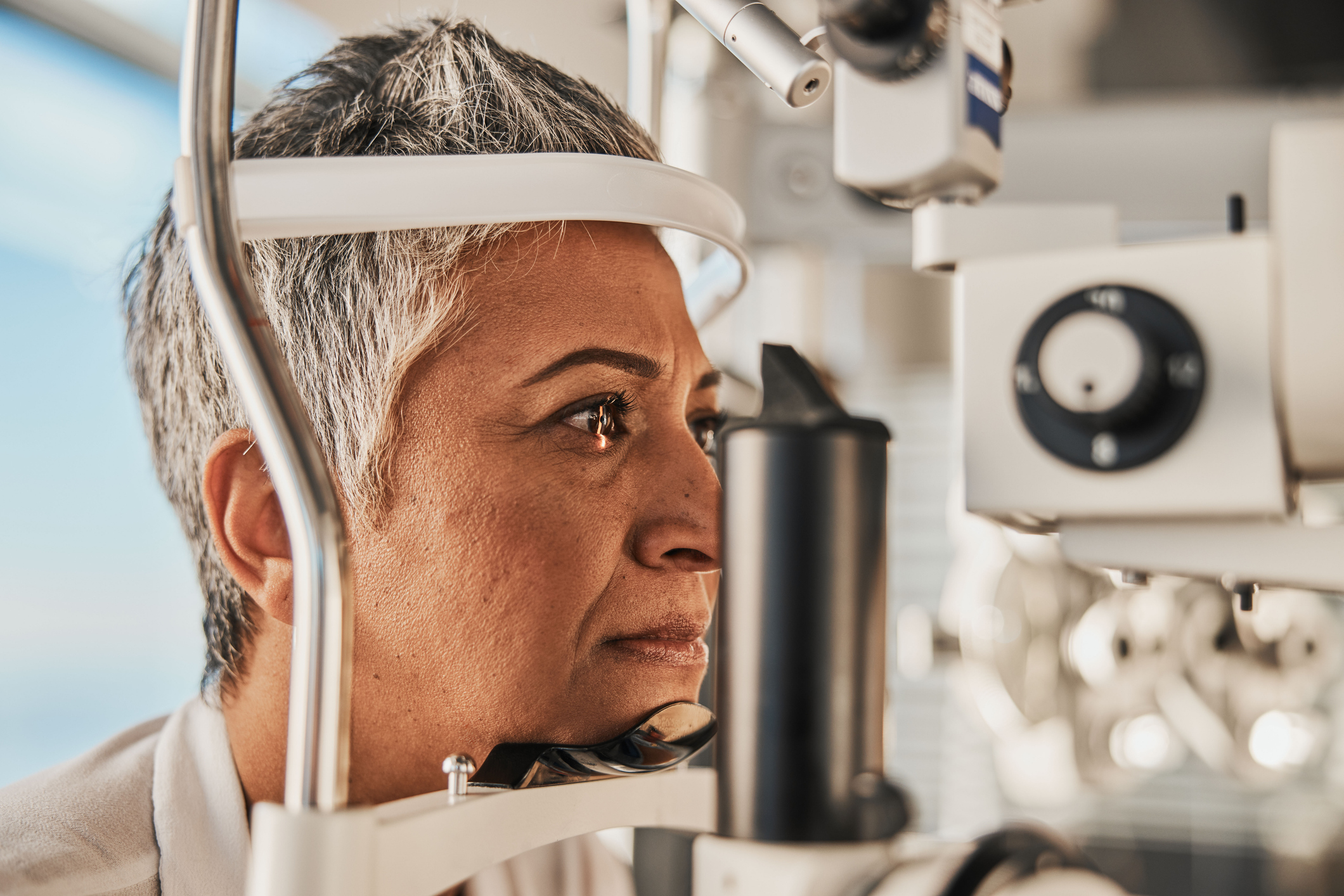Eight Tricks to Shop for Glasses if You're Over 50
Shopping for glasses often gets trickier — and more expensive — as you age. If you've over 50, take these steps when you set out to buy a new pair.


Life is simpler when you’re young. You can mow the lawn without breaking a sweat. Climb a tree without breaking a leg. Buy new prescription glasses in the blink of an eye.
But buying eyeglasses often gets more complicated somewhere around age 50. Single-vision lenses suddenly don’t help you decipher the small print on restaurant menus. Eye exams require more steps. Glasses get more layered, with add-ons for older folks with vision issues. And the prices for these more-complex glasses can shoot into the stratosphere.
Getting glasses may be more involved with age, but it need not induce as much stress as getting a new car. To help bring the process back to earth for folks 50 and older, we reached out to experts on vision and aging and have weaved their advice into this eight-step guide.
From just $107.88 $24.99 for Kiplinger Personal Finance
Become a smarter, better informed investor. Subscribe from just $107.88 $24.99, plus get up to 4 Special Issues

Sign up for Kiplinger’s Free Newsletters
Profit and prosper with the best of expert advice on investing, taxes, retirement, personal finance and more - straight to your e-mail.
Profit and prosper with the best of expert advice - straight to your e-mail.
1. Get an exam
This advice might sound obvious. But to save a few bucks, too many people try to use old or even outdated prescriptions to get new glasses. An exam is a must.
You can get one from your optometrist or ophthalmologist. Many eyeglass retailers will perform exams in their offices, too.
2. Shop around
Once you have an updated prescription, explore all your options for purchasing glasses. Most retailers offer package deals for frames, lenses and coatings, and these bundles can save serious money, says Michael Vitale, vice president of government relations at The Vision Council, a nonprofit trade association for manufacturers and suppliers of the optical industry.
Some retailers also offer discounts on purchases of two pairs of glasses or more.
“The most common mistake is not to do comparison shopping,” says Catherine Roberts, senior health reporter at Consumer Reports. In 2022, Consumer Reports surveyed 11,450 of its members who had purchased new glasses within the previous two years.
Most respondents said that for convenience, they bought their glasses at the doctor’s office where they had their eyes examined. When you make a choice for convenience, there is a good chance you’re missing out on better deals, Roberts says.
If you decide to buy glasses elsewhere, get a copy of your prescription from your eye doctor. And don’t hesitate to ask your eye doc for the name of the lowest-price place to purchase glasses, Roberts suggests.
3. Weigh the pros and cons of the bargain options
Odds are, you’ll be directed to a warehouse club or an online retailer, which will likely run you considerably less than buying glasses at your eye doctor’s office or from a major retail chain such as LensCrafters.
In the Consumer Reports survey, members who shopped at Costco Wholesale and online specialist Warby Parker paid a median $160 and $190, respectively, for a pair of glasses after insurance. But the median price at independent optical shops was $346 after insurance, or $511 out of pocket.
If you go with a wholesaler such as Costco or Sam’s Club, you can take advantage of both unbeatable prices and in-person assistance in selecting and fitting your glasses.
Respondents to the Consumer Reports survey ranked warehouse clubs very highly, not only for price but also for service and quality.
“You get a top-notch product at a reasonable price,” says Vitale. But keep in mind that warehouse clubs charge annual membership fees, and they may not accept all vision plans, he says.
If you shop with an online retailer such as Eyebuydirect, Warby Parker or Zenni Optical, you’ll enjoy cut-rate prices without stepping outside your home. But because older folks typically have more-complicated glasses prescriptions and are often more finicky about fit, online purchases might not be the best option, says Faheem Ahmed, an ophthalmologist at Eye Physicians of Virginia.
Consumer Reports suggests that the stronger and more complicated your lenses are, “the more you should lean towards buying in person.”
Unlike many other online retailers, Warby Parker also has physical locations where you can get exams and have a professional fit your glasses.
In the Consumer Reports survey, Warby Parker ranked “very high” in price, quality and service, says Roberts.
4. Compare vision insurance plans with optical-store discount plans
As you age, you probably need more-costly bifocals or progressive-lens glasses. So some form of vision insurance — or even an optical-store discount plan — can be financially beneficial for older adults, says Ahmed.
He estimates that about half of his patients do not have employer-sponsored vision plans, in part because many are retired. Some opt for optical-store discount plans, which typically require a membership fee (often about $25 to $50 annually) and are often best for less-frequent users.
If you have insurance, it’s usually cheapest to use your plan’s in-network providers. If you don’t have insurance or an optical-store discount plan, try to negotiate up front with the provider to get the best prices.
5. Beware the limits of Medicare
Many people who are 65 or older are surprised to discover that routine eye exams, eyeglasses and contact lenses are not covered by Medicare.
However, for some conditions, such as macular degeneration and cataracts, Medicare does pay for testing and treatment, according to the National Council on Aging.
Most Medicare Advantage (Part C) plans offer vision care benefits that go beyond what original Medicare covers, including routine eye exams to check your vision and eye health and an eyewear allowance to help pay for glasses or contact lenses. Coverage varies from plan to plan.
6. Choose coatings carefully
Coatings come in a dizzying array of options. Older people will probably want anti-glare coatings because the coatings can greatly help with night driving, says Ahmed.
But think twice before purchasing a coating for blue-light filtering. These filters act to cut back screen light from electronics such as cell phones and laptops and can sometimes help those who suffer from migraines.
But Ahmed says there is no scientific evidence that blue light can damage your eyes.
7. Don’t overlook transition lenses
If you need prescription sunglasses in addition to standard glasses, you can save money by getting transition lenses, says Ahmed. That way, you might need to purchase one pair of prescription glasses instead of two.
These lenses, also known as photochromic lenses, automatically darken (to act as sunglasses) when exposed to ultraviolet light and lighten when the UV light source is removed.
Using transition lenses is also easier than carrying two pairs of glasses and switching between them. And, Ahmed estimates, because you are purchasing just one pair of glasses instead of two, it can save you $300 to $500.
Be aware that when you’re in a vehicle, your photochromic lenses may not darken fully if the car’s windshield blocks a lot of UV light, says Ahmed. Certain lenses, however, including Transitions XTRActive, can work quite well for daytime driving, he says.
8. Take care of your glasses
Perhaps the best way to save money on new glasses is to take care of your old ones, says Roberts. The pair of glasses you don’t have to buy is money in your pocket.
That means breaking the worst of habits: using your T-shirt to wipe the smudges off your lenses. Instead, always use a lens cloth and cleaner, says Roberts.
Carry your glasses in a hard — not soft — case when you’re not wearing them. When you take your glasses off, do so with both hands to avoid loosening or bending the frames.
Finally, when you do need new lenses, it doesn’t necessarily mean you need new frames, too. If your new prescription will work with your old frames, says Roberts, you could save hundreds of dollars by asking your optician to plop the new lenses into the frames you already own.
Note: This item first appeared in Kiplinger Personal Finance Magazine, a monthly, trustworthy source of advice and guidance. Subscribe to help you make more money and keep more of the money you make here.
Related content
Profit and prosper with the best of Kiplinger's advice on investing, taxes, retirement, personal finance and much more. Delivered daily. Enter your email in the box and click Sign Me Up.

Bruce Horovitz is a journalist whose byline is recognized nationally. He was the marketing columnist for the Los Angeles Times for a decade and USA TODAY's marketing writer for two decades. His freelance work has appeared in the New York Times, Wall Street Journal, The Washington Post, Time magazine, AARP Magazine, Investor's Business Daily and The Cleveland Plain Dealer.
-
 Gold and Silver Shine as Stocks Chop: Stock Market Today
Gold and Silver Shine as Stocks Chop: Stock Market TodayStocks struggled in Friday's low-volume session, but the losses weren't enough to put the Santa Claus Rally at risk.
-
 Don't Wait Until January: Your Year-End Health Checklist to Kickstart 2026
Don't Wait Until January: Your Year-End Health Checklist to Kickstart 2026Skip the fleeting resolutions and start the new year with a proactive plan to optimize your longevity, cognitive health, and social vitality.
-
 Premium Rewards Cards: More Perks, Higher Fees
Premium Rewards Cards: More Perks, Higher FeesSome issuers are hiking the annual fee on their flagship luxury credit cards by hundreds of dollars. Are they still worth using?
-
 Premium Rewards Cards: More Perks, Higher Fees
Premium Rewards Cards: More Perks, Higher FeesSome issuers are hiking the annual fee on their flagship luxury credit cards by hundreds of dollars. Are they still worth using?
-
 3 Trips to Escape the Winter Doldrums, Including An Epic Cruise
3 Trips to Escape the Winter Doldrums, Including An Epic CruiseThree winter vacation ideas to suit different types of travelers.
-
 4 Financially Savvy Things to Do with Unwanted Gifts
4 Financially Savvy Things to Do with Unwanted GiftsDon't send that unwanted gift to the landfill. Find a way to squeeze out some of its cash value instead.
-
 I'm an Insurance Expert: Sure, There's Always Tomorrow to Report Your Claim, But Procrastination Could Cost You
I'm an Insurance Expert: Sure, There's Always Tomorrow to Report Your Claim, But Procrastination Could Cost YouThe longer you wait to file an insurance claim, the bigger the problem could get — and the more leverage you're giving your insurer to deny it.
-
 How to Leave Different Amounts to Adult Children Without Causing a Rift
How to Leave Different Amounts to Adult Children Without Causing a RiftHere’s how to leave different amounts to adult children without causing a family rift.
-
 Introducing Your CD's Edgier Cousin: The Market-Linked CD
Introducing Your CD's Edgier Cousin: The Market-Linked CDTraditional CDs are a safe option for savers, but they don't always beat inflation. Should you try their counterparts, market-linked CDs, for better returns?
-
 How to Protect Yourself and Others From a Troubled Adult Child: A Lesson from Real Life
How to Protect Yourself and Others From a Troubled Adult Child: A Lesson from Real LifeThis case of a violent adult son whose parents are in denial is an example of the extreme risks some parents face if they neglect essential safety precautions.
-
 Here's How Much You Can Earn with a $100,000 Jumbo CD
Here's How Much You Can Earn with a $100,000 Jumbo CDYou might be surprised at how fast a jumbo CD helps you reach your goals.